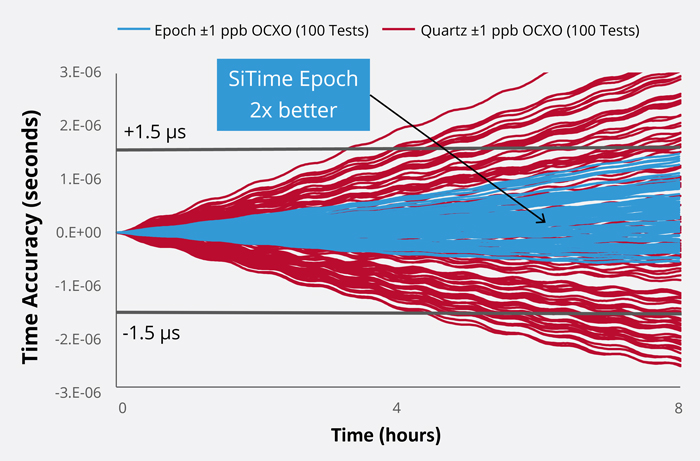廣為科技
The Evolution of Precision Timing Solutions
In an ever-evolving technological landscape, precision timing plays an increasingly important role in system performance and reliability, especially when it comes to critical infrastructure such as AI computing platforms, 5G base stations, and cloud datacenters. Enter SiTime's Epoch Platform™, a silicon MEMS-based precision timing solution delivering a state-of-the-art advancement in oscillator technology that promises to redefine industry standards.
Image

Introducing SiTime's industry-leading Epoch Platform
SiTime's new Epoch Platform stands out as the industry’s smallest and lowest power oven-controlled oscillator (OCXO) family, capable of ±1 ppb stability over temperature, a key milestone for high performance timing. With a formfactor of just 9.0 x 7.0 x 3.6 mm, the footprint of Epoch OCXOs are 9x smaller and the volume is 25x less than comparable ±1 ppb quartz OCXOs. And the 420 mW power consumption in steady state is 3x lower. Ultra-small size and low power aren’t the only distinguishing factors of the new Epoch Platform OCXOs. With 3x lower Hadamard deviation (HDEV) under airflow, low aging, and excellent frequency over temp slope (dT/dF), these oscillators offer unrivaled holdover in real-world conditions. This ensures 2x better service continuity.
A key innovation underpinning the Epoch Platform is SiTime’s unique DualMEMS® and TurboCompensation® temperature sensing technology. These innovations ensure impeccable precision timing even when faced with external stressors such as airflow and rapid temperature fluctuations.
How does the Epoch Platform achieve unmatched performance?
Let’s dive deep, the platform integrates a MEMS resonator system with the timing industry’s most accurate temperature sensor, thereby achieving unparalleled dynamic stability, ultra-low phase noise, and a broad frequency range. Key elements that set the Epoch Platform apart include:
- TempFlat MEMS® Technology - Enables 10x more resilient to temperature than traditional quartz resonators, eliminating activity dips. The ultra-small resonator, with extremely low mass, reduces the effect of g-force and results in 30x better vibration immunity.
- DualMEMS Temperature Sensing - Features 100% thermal coupling to ensure 40x faster temperature tracking, a critical feature especially under fluctuating airflow and rapid temperature variations.
- Integrated Mixed-Signal Circuits - Designed for 5x better immunity to power-supply noise and a 30 µK temperature resolution, which is 10x better than quartz.
- Heater Control Circuit - Maintains an almost constant temperature inside the package, ensuring consistent oscillator performance.
Why does the Epoch Platform matter?
The Epoch Platform MEMS OCXO reinvents the holdover oscillator, a critical component of reliable networks. In layman’s terms, a network node enters holdover when its primary time reference is lost and the local clock, often an OCXO, becomes the time reference until the primary is restored. Holdover is critical to maintaining service continuity when the primary time reference is disrupted. This can happen because of a malfunctioning grandmaster clock elsewhere in the network or interruptions in GNSS due to inclement weather, an increasing concern.
The Epoch Platform's exceptional resilience to environmental stressors means that it enables 2x better service continuity in real-world conditions such as temperature change, airflow, vibration, shock, and electromagnetic interference (EMI). The figure below shows 100 holdover tests of both the Epoch Platform MEMS OCXO and a comparable ±1 ppb quartz OCXO. Tested during an 8 degree Celsius temperature cycle and breezy airflow up to 1 meter per second, the Epoch Platform MEMS OCXO delivers 2x less time error after 8 hours. To add an application perspective, consider the rigorous requirements of a 5G base station infrastructure, where the specified period is ±1.5 µsec. Oscillators must maintain this stringent time alignment for normal operations. The Epoch Platform not only meets but aims to exceed this requirement, striving for 8 hours or more hours of holdover over this ±1.5 µsec period.
Image

Holdover test of ±1-ppb Epoch Platform MEMS OCXOs and comparable ±1-ppb quartz OCXOs from one of the largest quartz vendors. Tested during an 8°C temperature cycle and breezy airflow up to 1 meter per second, to induce rapid temperature change. The Epoch Platform MEMS OCXO delivers 2x less time error after 8 hours.
How does the Epoch Platform impact critical applications?
SiTime's Epoch Platform is poised to make significant inroads in various markets, notably networking, datacenters, and telecom equipment. The robustness and resilience of the platform, coupled with its dynamic performance, make it particularly ideal for remote deployments in emerging technology frontiers such as 5G communications, advanced datacenters, and comprehensive network infrastructure.
As the technological world moves toward an era where timing precision, reliability and adaptability are paramount, SiTime’s Epoch Platform emerges as a beacon of progress, leading the way with unmatched performance, stability, scalability, and versatility. As general samples become available in October 2023, the industry keenly awaits the transformative impact of these novel oscillators in real-world applications. The future of MEMS timing solutions has never looked more promising.
